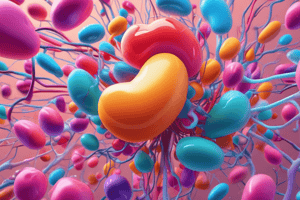Podcast
Questions and Answers
What is the primary mechanism of action of procainamide?
What is the primary mechanism of action of procainamide?
- Increases calcium influx into cells
- Blocks sodium channels (correct)
- Facilitates adrenergic receptor stimulation
- Inhibits potassium channels
Which condition is procainamide particularly effective in managing?
Which condition is procainamide particularly effective in managing?
- Ventricular tachycardia (correct)
- Myocardial infarction
- Bradycardia
- Aortic stenosis
Which is a common side effect of procainamide, especially with prolonged use?
Which is a common side effect of procainamide, especially with prolonged use?
- Drug-induced lupus erythematosus (correct)
- Pulmonary edema
- Hyperglycemia
- Hypokalemia
What is true about the pharmacokinetics of procainamide?
What is true about the pharmacokinetics of procainamide?
What is a significant drug interaction concern when using procainamide?
What is a significant drug interaction concern when using procainamide?
Which condition is a contraindication for procainamide administration?
Which condition is a contraindication for procainamide administration?
What serious side effect is associated with the use of procainamide?
What serious side effect is associated with the use of procainamide?
In which patient population should procainamide be used with caution?
In which patient population should procainamide be used with caution?
What is an important monitoring requirement during intravenous administration of procainamide?
What is an important monitoring requirement during intravenous administration of procainamide?
What is the primary route of elimination for procainamide in the body?
What is the primary route of elimination for procainamide in the body?
What is a recommended action for patients prescribed procainamide?
What is a recommended action for patients prescribed procainamide?
Which of the following can contribute to the increased risk of mortality with procainamide use?
Which of the following can contribute to the increased risk of mortality with procainamide use?
What is the potential risk associated with blood dyscrasias when using procainamide?
What is the potential risk associated with blood dyscrasias when using procainamide?
Considering the contraindications of procainamide, which of the following patients should avoid this medication?
Considering the contraindications of procainamide, which of the following patients should avoid this medication?
What precaution should be taken when prescribing procainamide to elderly patients?
What precaution should be taken when prescribing procainamide to elderly patients?
What is the primary reason for monitoring patients taking procainamide?
What is the primary reason for monitoring patients taking procainamide?
Which of the following is a contraindication for using procainamide?
Which of the following is a contraindication for using procainamide?
What symptom should patients be counseled to report while taking procainamide?
What symptom should patients be counseled to report while taking procainamide?
What type of monitoring is essential for patients prescribed procainamide?
What type of monitoring is essential for patients prescribed procainamide?
Which of the following conditions requires special caution when prescribing procainamide?
Which of the following conditions requires special caution when prescribing procainamide?
Flashcards are hidden until you start studying
Study Notes
Procainamide Mechanism of Action
- Procainamide acts as a sodium channel blocker, interfering with the rapid influx of sodium ions into myocardial cells. This action suppresses the initiation and conduction of cardiac impulses, thereby slowing the heart rate and reducing the risk of ventricular arrhythmias.
Procainamide's Therapeutic Use
- Procainamide is particularly effective in managing atrial fibrillation, a type of irregular heartbeat characterized by rapid and uncoordinated contractions of the atria.
Procainamide Side Effects
- A common side effect of procainamide, especially with prolonged use, is lupus-like syndrome. This autoimmune reaction can cause symptoms such as joint pain, fever, and skin rashes.
Procainamide Pharmacokinetics
- Procainamide is metabolized in the liver and excreted primarily by the kidneys.
Procainamide Drug Interactions
- Digoxin is a significant drug interaction concern when using procainamide. Procainamide can increase the levels of digoxin in the body, potentially leading to toxic effects.
Procainamide Contraindications
- Complete heart block is a contraindication for procainamide administration as it can worsen conduction abnormalities.
Procainamide Serious Side Effects
- Procainamide is associated with a serious side effect called agranulocytosis, a condition characterized by a severe decrease in white blood cell count, increasing the risk of infections.
Procainamide Use in Specific Populations
- Procainamide should be used with caution in patients with renal insufficiency, as it may accumulate in the body and increase the risk of adverse effects.
Procainamide Monitoring During Intravenous Administration
- During intravenous administration of procainamide, careful monitoring of blood pressure and ECG is critical.
Procainamide Elimination
- The primary route of elimination for procainamide in the body is through renal excretion.
Procainamide Patient Education
- Patients prescribed procainamide should be advised to report any signs of infection to their healthcare provider.
Procainamide Mortality Risk
- The increased risk of mortality with procainamide use can be contributed to factors including progressive heart failure, chronic obstructive pulmonary disease, and older age.
Procainamide Blood Dyscrasias
- Procainamide carries a potential risk of blood dyscrasias, which involve abnormalities in blood cells, such as anemia and thrombocytopenia.
Patient Contraindications for Procainamide
- Patients with known hypersensitivity to procainamide or other local anesthetics should avoid this medication.
Procainamide Elderly Patient Considerations
- When prescribing procainamide to elderly patients, dose adjustments may be necessary due to age-related changes in liver and kidney function.
Procainamide Monitoring Importance
- Monitoring patients taking procainamide is essential to detect and manage potential adverse effects such as lupus-like syndrome, agranulocytosis, and cardiac toxicity.
Procainamide Contraindication
- Myasthenia gravis is a contraindication for using procainamide as it can exacerbate muscle weakness.
Report Specific Symptom
- Patients on procainamide should be counseled to report any signs of lupus-like syndrome, including joint pain, fatigue, fever, and skin rashes.
Procainamide Monitoring Type
- Continuous ECG monitoring, along with regular blood tests to assess kidney and liver function, are essential for patients prescribed procainamide.
Procainamide Special Caution
- Pregnancy, breastfeeding, and certain liver or kidney conditions require special caution when prescribing procainamide.
Studying That Suits You
Use AI to generate personalized quizzes and flashcards to suit your learning preferences.




